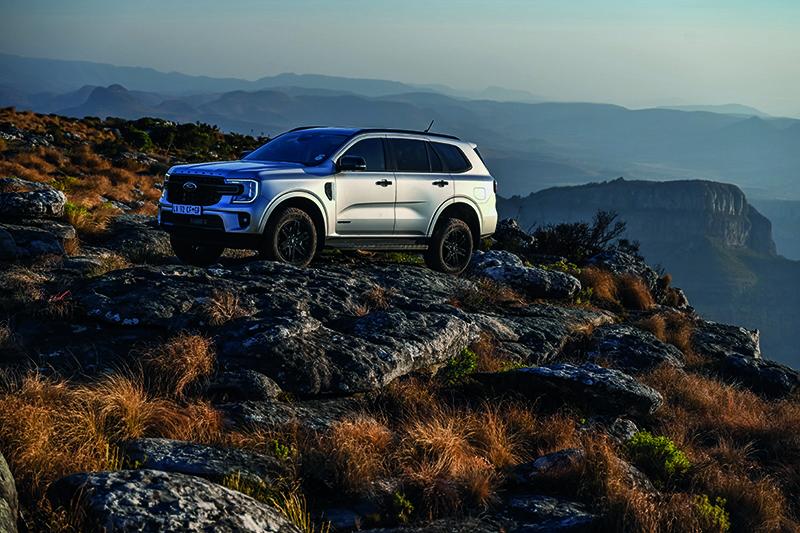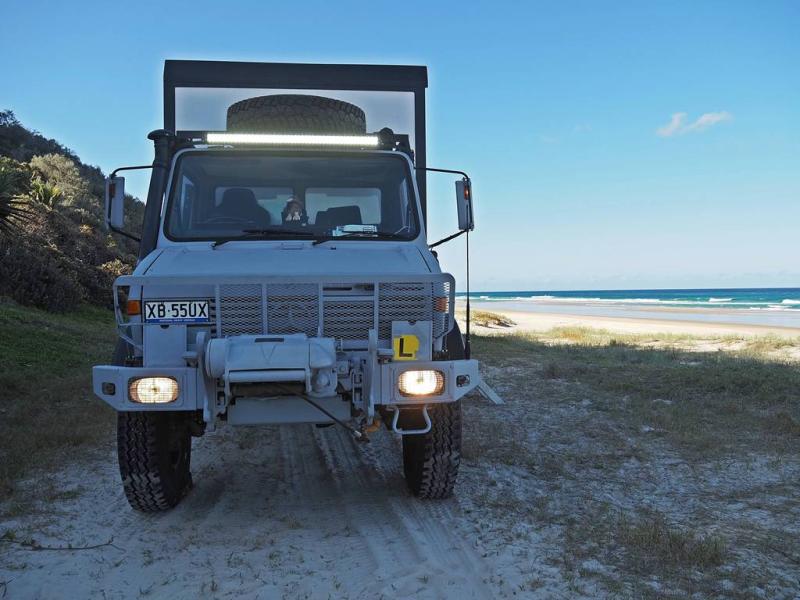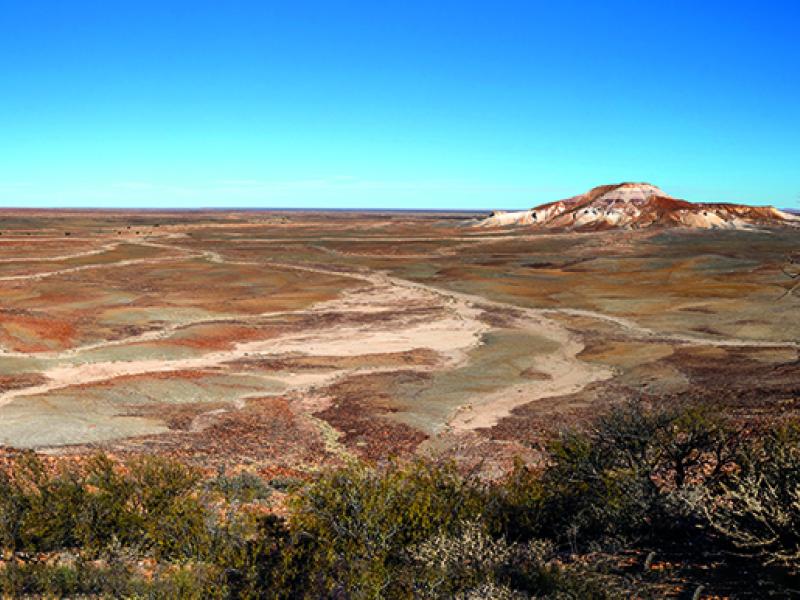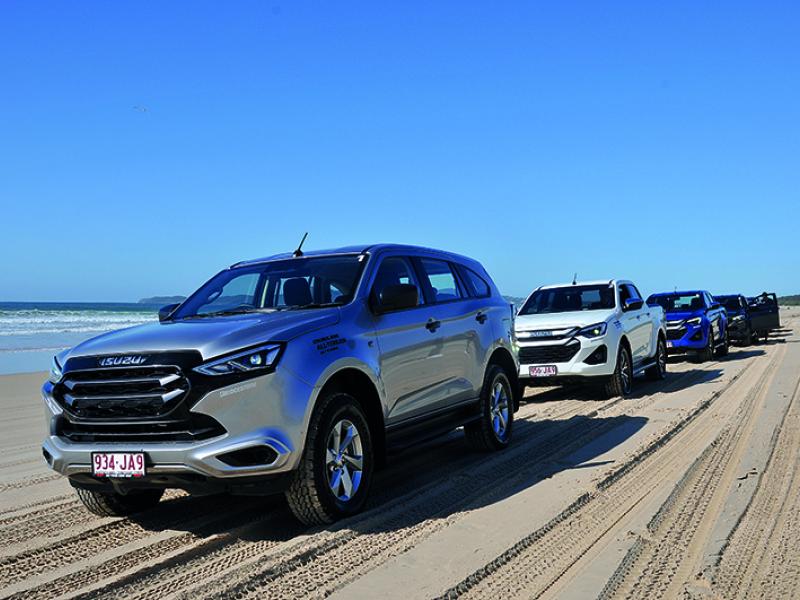Dave McLeod, editor of NZ4WD’s sister publication Company Vehicle, was invited on a memorable trip to Africa driving Ford’s Everest SUV. Here’s what he saw, and did.
Explorer on safari in Africaspecies), that all thrive in this natural habitat.
The grounds are intersected with thousands of kilometres of unsealed roads where, led by a professional tracker in an extended wheelbase Toyota, we drove in convoy seeking out the wildlife I had previously only seen in zoos.
The initial part of my exploration was conducted in the 2.0 litre Sport and in 2WD, with the dusty gravel offering little challenge to the large seven-seater Everest riding on its 18-inch alloys. It didn’t take long for us to spot a few giraffes and zebras grazing on the local foliage and in all fairness, they appeared unfazed by the line of eager-eyed tourists in our suburban SUVs.
The Everest’s cabin itself offered both upmarket comfort and, with its high-riding size and large windows, great visibility. And while the temperatures outside were nudging towards a baking 30-degrees, our AC was set at cool 18 – who says Safaris have to be unpleasant?
Apparently, tracking some of the harder to spot ‘5’ meant venturing a little further off track, and that meant turning the drive mode dial and engaging ‘Sand’. Sand mode is designed to be used on both sand and deep snow and optimises gear shifts with lower gears held longer to help maintain momentum, similarly stability control intervention is reduced to ensure the vehicle can keep moving forward through soft, dry sand.
This may sound like a lot going on, but for me the driver, I just had to keep the SUV pointing in the right direction and keep the momentum up – not exactly tough work. And although the sand got pretty deep in places, thankfully, I still had time to look out of the window and was rewarded with a few lions feasting on a giraffe carcass. It may appear brutal, but it’s just life in the wild.
All in all, we managed to see hippos at the waterholes, numerous giraffes, zebras, impalas and the bones of a cape buffalo. We tracked, but were unable to see a rhino and watched a lion make out with its partner, but that’s a story for another day.
The next morning we were up early for a more arduous climb up the Mariepskop mountain, the highest mountain peak in the eastern Drakensberg Escarpment. The peak stands with its back to the Blyde River Canyon 1945 metres above sea level; with Maputo and the Indian Ocean visible on a clear day.
In order to get there, we travelled a short stint along the tarseal of the R40 before heading onto the gravel trail where the pass began. My ride for the day was the top-of-the-line Platinum – if you’re gonna climb a mountain, you might as well do it in style.
The pass proper starts alongside the southern bank of the Motlasedi River, which it crosses via a small bridge before heading deep into forest. However, in true Everest style, we opted to switch into 4L and ford the stream, testing out the SUVs 800mm wading depth.
The journey to the summit is an adventure in itself, with a labyrinth of gravel and tarred roads leading you through stunning landscapes, it’s an experience worth the trip to Africa for all by itself.
The next test for the Everest was a deeply rutted unsealed stretch of road that had the SUV’s front and rear wheels waving to the crowd while its ladder frame remained stoic. From the outside, watching a large SUV pitch and roll along gaping ruts and giant troughs is dramatic, but from the cabin it was a more serene experience, with just gentle throttle and braking required. In all honesty I felt like I was the master of off-road driving, but in all fairness, it was the Everet’s smart Terrain Management System doing all the heavy lifting.
After a while the pass heads north, rising rapidly up the mountainside. Crossing the boundary between Limpopo and Mpumalanga twice, there are a series of twists and turns before reaching the village of Mariepskop Forestry Station. The road then bypasses the village, reaching the tarred section of the road at a Y-junction.
As the pass ascended towards the summit, we were greeted by a thick mix of cloud and mist. Visibility all around was limited, creating an otherworldly atmosphere, particularly as you’re driving through what feels like a rainforest. Seriously it was a another day.
The next morning we were up early for a more arduous climb up the Mariepskop mountain, the highest mountain peak in the eastern Drakensberg Escarpment. The peak stands with its back to the Blyde River Canyon 1945 metres above sea level; with Maputo and the Indian Ocean visible on a clear day.
In order to get there, we travelled a short stint along the tarseal of the R40 before heading onto the gravel trail where the pass began. My ride for the day was the top-of-the-line Platinum – if you’re gonna climb a mountain, you might as well do it in style.
The pass proper starts alongside the southern bank of the Motlasedi River, which it crosses via a small bridge before heading deep into forest. However, in true Everest style, we opted to switch into 4L and ford the stream, testing out the SUVs 800mm wading depth.
The journey to the summit is an adventure in itself, with a labyrinth of gravel and tarred roads leading you through stunning landscapes, it’s an experience worth the trip to Africa for all by itself.
The next test for the Everest was a deeply rutted unsealed stretch of road that had the SUV’s front and rear wheels waving to the crowd while its ladder frame remained stoic. From the outside, watching a large SUV pitch and roll along gaping ruts and giant troughs is dramatic, but from the cabin it was a more serene experience, with just gentle throttle and braking required. In all honesty I felt like I was the master of off-road driving, but in all fairness, it was the Everet’s smart Terrain Management System doing all the heavy lifting.
After a while the pass heads north, rising rapidly up the mountainside. Crossing the boundary between Limpopo and Mpumalanga twice, there are a series of twists and turns before reaching the village of Mariepskop Forestry Station. The road then bypasses the village, reaching the tarred section of the road at a Y-junction.
As the pass ascended towards the summit, we were greeted by a thick mix of cloud and mist. Visibility all around was limited, creating an otherworldly atmosphere, particularly as you’re driving through what feels like a rainforest. Seriously it was a another day.
The next morning we were up early for a more arduous climb up the Mariepskop mountain, the highest mountain peak in the eastern Drakensberg Escarpment. The peak stands with its back to the Blyde River Canyon 1945 metres above sea level; with Maputo and the Indian Ocean visible on a clear day.
In order to get there, we travelled a short stint along the tarseal of the R40 before heading onto the gravel trail where the pass began. My ride for the day was the top-of-the-line Platinum – if you’re gonna climb a mountain, you might as well do it in style.
The pass proper starts alongside the southern bank of the Motlasedi River, which it crosses via a small bridge before heading deep into forest. However, in true Everest style, we opted to switch into 4L and ford the stream, testing out the SUVs 800mm wading depth.
The journey to the summit is an adventure in itself, with a labyrinth of gravel and tarred roads leading you through stunning landscapes, it’s an experience worth the trip to Africa for all by itself.
The next test for the Everest was a deeply rutted unsealed stretch of road that had the SUV’s front and rear wheels waving to the crowd while its ladder frame remained stoic. From the outside, watching a large SUV pitch and roll along gaping ruts and giant troughs is dramatic, but from the cabin it was a more serene experience, with just gentle throttle and braking required. In all honesty I felt like I was the master of off-road driving, but in all fairness, it was the Everet’s smart Terrain Management System doing all the heavy lifting.
After a while the pass heads north, rising rapidly up the mountainside. Crossing the boundary between Limpopo and Mpumalanga twice, there are a series of twists and turns before reaching the village of Mariepskop Forestry Station. The road then bypasses the village, reaching the tarred section of the road at a Y-junction.
As the pass ascended towards the summit, we were greeted by a thick mix of cloud and mist. Visibility all around was limited, creating an otherworldly atmosphere, particularly as you’re driving through what feels like a rainforest. Seriously it was a complete contrast to the dusty trail that we had been climbing along a few moments before.
The final leg of the pass is the country’s second biggest, rapidly gaining 1100 metres in altitude.
Once you’ve reached the lofty heights of Mariepskop, you feel like you’re on the edge of the world, engulfed by breathtaking panoramas that seem to stretch on forever. At the summit, there are the remnants of an old SAAF radar station, a tall microwave tower, and forestry fire lookout posts. This area, protected due to this military presence, has remained a sanctuary of wilderness, preserving its natural beauty and biodiversity.
In stark contrast to the Kapama Game Reserve, Mariepskop’s plant diversity is nothing short of astonishing, surpassing even that of Table Mountain with over 1,400 floral species and 2,000 plant varieties. At its foothills lies the expansive Savannah biome, while its slopes are a tapestry of pristine montane forests. Moreover, the crystal-clear Klaserie River finds its source amidst the rugged beauty of this mountain. Simply put, the entire climb is a feast for the senses while being a real test of the Everest’s capabilities.
The ride down was of course a reverse of the climb. Again, the Everest lapped up the experience, offering a cradled drive back to reality.
As a country, South Africa is a truly amazing adventure playground and an experience that pictures don’t do justice to. There is so much to see and do, and on terrain that is both thrilling and unique.






